Financial Accounting II: Intangible Assets and Contingent Liabilities
VerifiedAdded on 2023/06/06
|7
|1533
|196
Report
AI Summary
This report addresses two key financial accounting issues faced by Pewter Ltd, focusing on the application of AASB 138 concerning intangible assets and AASB 137 regarding provisions, contingent liabilities, and contingent assets. The first issue involves recognizing environmental responsibility efforts, specifically repairing a ship involved in anti-whaling activities, as an intangible asset. The analysis concludes that while this may enhance the company's reputation and potentially increase customer base, it constitutes internally generated goodwill and cannot be reliably measured, thus should not be recorded as an intangible asset. The second issue concerns a guarantee offered for potential damage to the same ship, which is evaluated as a contingent liability that requires disclosure in the notes to the financial statements but is not recognized as a provision until the damage occurs and the expense amount is confirmed. The report provides detailed suggestions based on the relevant accounting standards, offering clarity on the appropriate treatment of these items in Pewter Ltd's financial reporting.
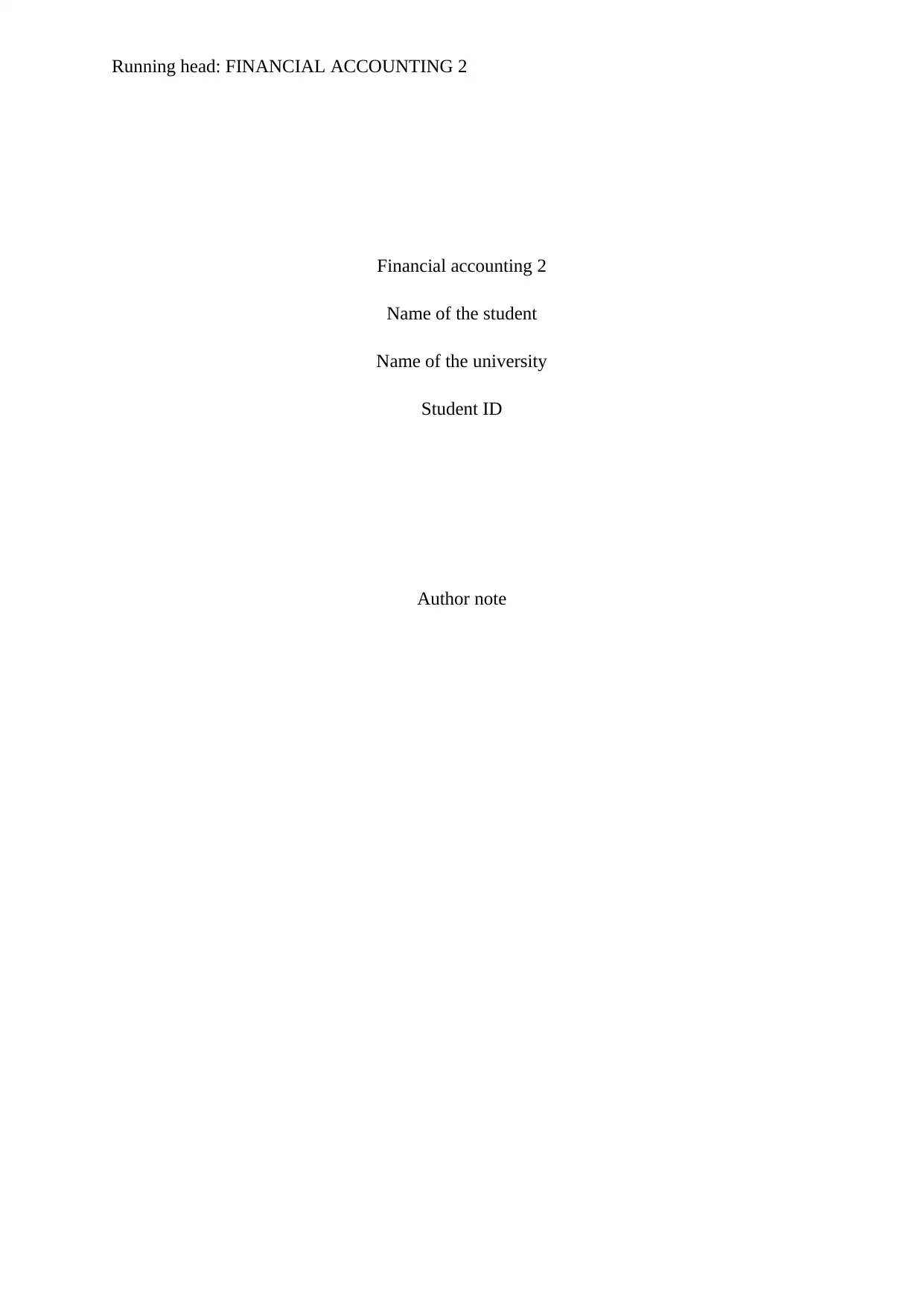
Running head: FINANCIAL ACCOUNTING 2
Financial accounting 2
Name of the student
Name of the university
Student ID
Author note
Financial accounting 2
Name of the student
Name of the university
Student ID
Author note
Paraphrase This Document
Need a fresh take? Get an instant paraphrase of this document with our AI Paraphraser
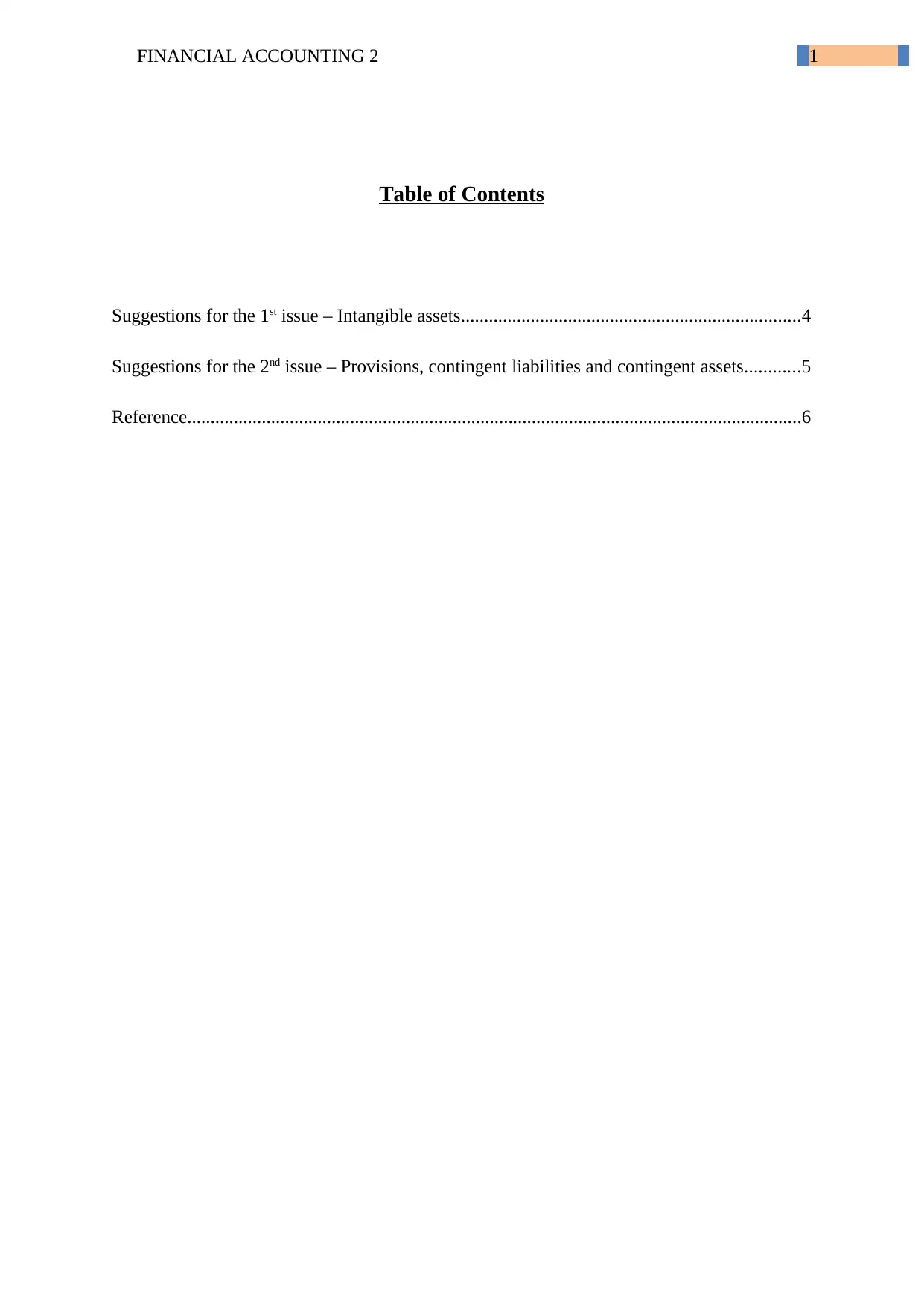
FINANCIAL ACCOUNTING 2 1
Table of Contents
Suggestions for the 1st issue – Intangible assets.........................................................................4
Suggestions for the 2nd issue – Provisions, contingent liabilities and contingent assets............5
Reference....................................................................................................................................6
Table of Contents
Suggestions for the 1st issue – Intangible assets.........................................................................4
Suggestions for the 2nd issue – Provisions, contingent liabilities and contingent assets............5
Reference....................................................................................................................................6
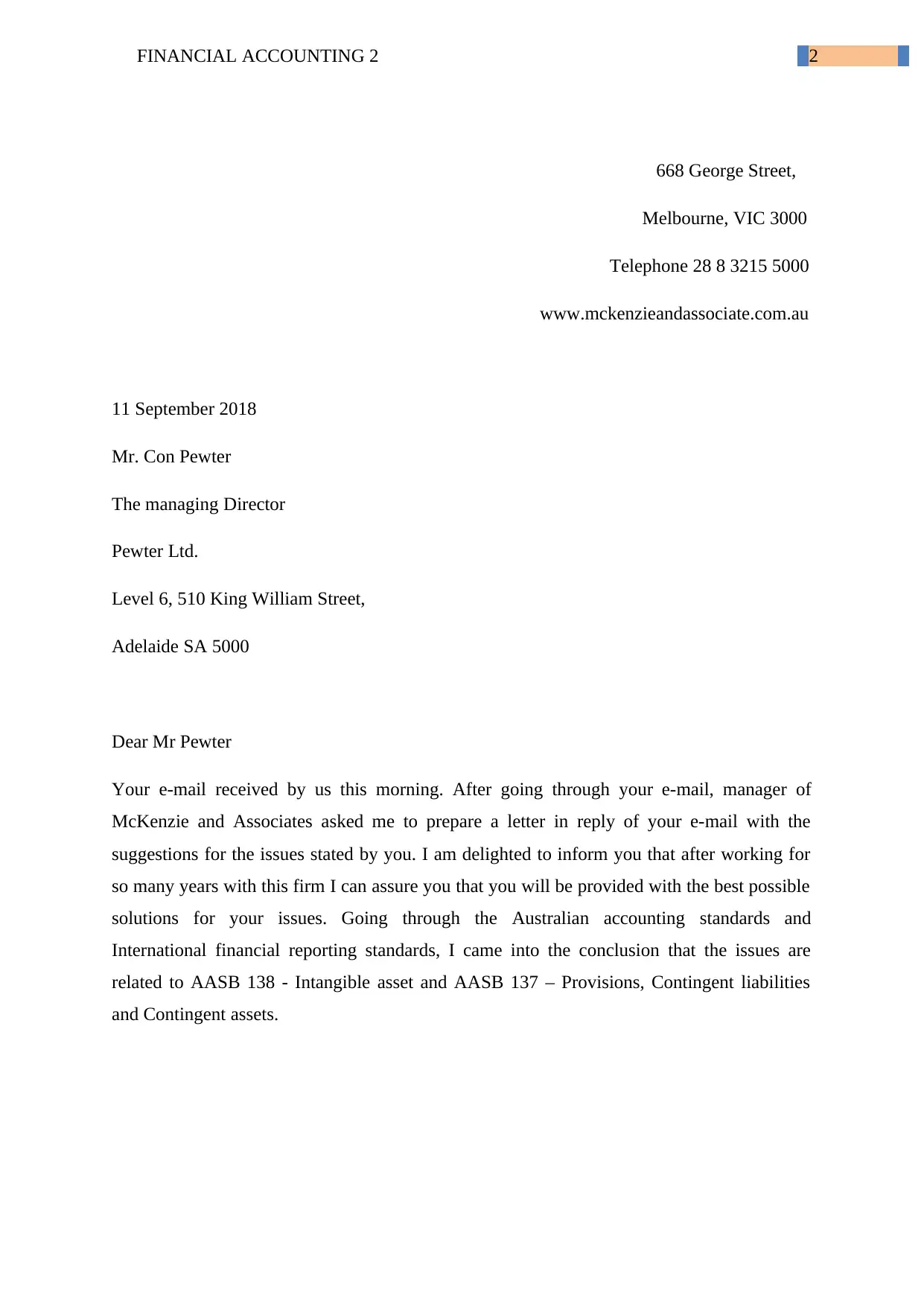
FINANCIAL ACCOUNTING 2 2
668 George Street,
Melbourne, VIC 3000
Telephone 28 8 3215 5000
www.mckenzieandassociate.com.au
11 September 2018
Mr. Con Pewter
The managing Director
Pewter Ltd.
Level 6, 510 King William Street,
Adelaide SA 5000
Dear Mr Pewter
Your e-mail received by us this morning. After going through your e-mail, manager of
McKenzie and Associates asked me to prepare a letter in reply of your e-mail with the
suggestions for the issues stated by you. I am delighted to inform you that after working for
so many years with this firm I can assure you that you will be provided with the best possible
solutions for your issues. Going through the Australian accounting standards and
International financial reporting standards, I came into the conclusion that the issues are
related to AASB 138 - Intangible asset and AASB 137 – Provisions, Contingent liabilities
and Contingent assets.
668 George Street,
Melbourne, VIC 3000
Telephone 28 8 3215 5000
www.mckenzieandassociate.com.au
11 September 2018
Mr. Con Pewter
The managing Director
Pewter Ltd.
Level 6, 510 King William Street,
Adelaide SA 5000
Dear Mr Pewter
Your e-mail received by us this morning. After going through your e-mail, manager of
McKenzie and Associates asked me to prepare a letter in reply of your e-mail with the
suggestions for the issues stated by you. I am delighted to inform you that after working for
so many years with this firm I can assure you that you will be provided with the best possible
solutions for your issues. Going through the Australian accounting standards and
International financial reporting standards, I came into the conclusion that the issues are
related to AASB 138 - Intangible asset and AASB 137 – Provisions, Contingent liabilities
and Contingent assets.
⊘ This is a preview!⊘
Do you want full access?
Subscribe today to unlock all pages.

Trusted by 1+ million students worldwide
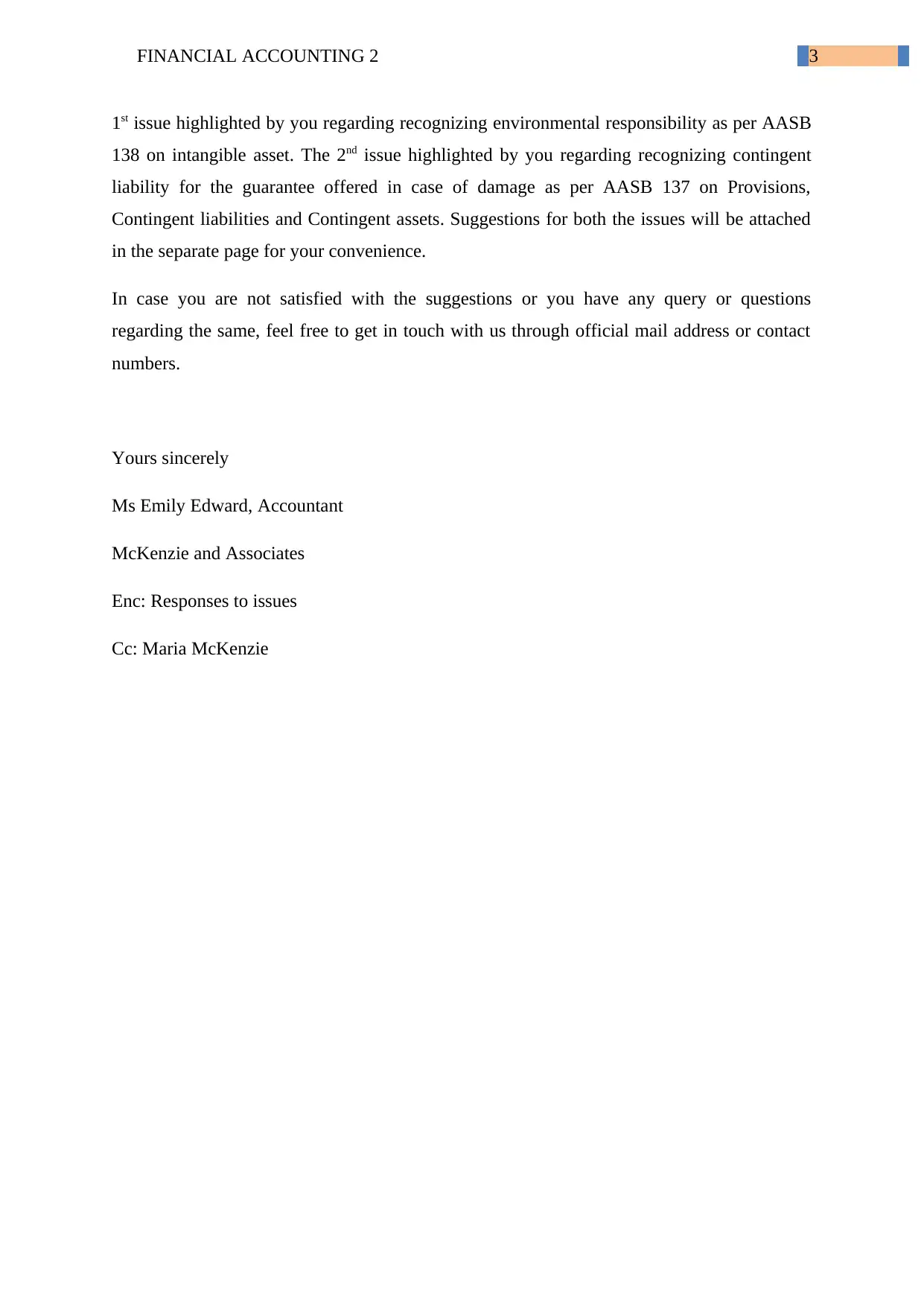
FINANCIAL ACCOUNTING 2 3
1st issue highlighted by you regarding recognizing environmental responsibility as per AASB
138 on intangible asset. The 2nd issue highlighted by you regarding recognizing contingent
liability for the guarantee offered in case of damage as per AASB 137 on Provisions,
Contingent liabilities and Contingent assets. Suggestions for both the issues will be attached
in the separate page for your convenience.
In case you are not satisfied with the suggestions or you have any query or questions
regarding the same, feel free to get in touch with us through official mail address or contact
numbers.
Yours sincerely
Ms Emily Edward, Accountant
McKenzie and Associates
Enc: Responses to issues
Cc: Maria McKenzie
1st issue highlighted by you regarding recognizing environmental responsibility as per AASB
138 on intangible asset. The 2nd issue highlighted by you regarding recognizing contingent
liability for the guarantee offered in case of damage as per AASB 137 on Provisions,
Contingent liabilities and Contingent assets. Suggestions for both the issues will be attached
in the separate page for your convenience.
In case you are not satisfied with the suggestions or you have any query or questions
regarding the same, feel free to get in touch with us through official mail address or contact
numbers.
Yours sincerely
Ms Emily Edward, Accountant
McKenzie and Associates
Enc: Responses to issues
Cc: Maria McKenzie
Paraphrase This Document
Need a fresh take? Get an instant paraphrase of this document with our AI Paraphraser
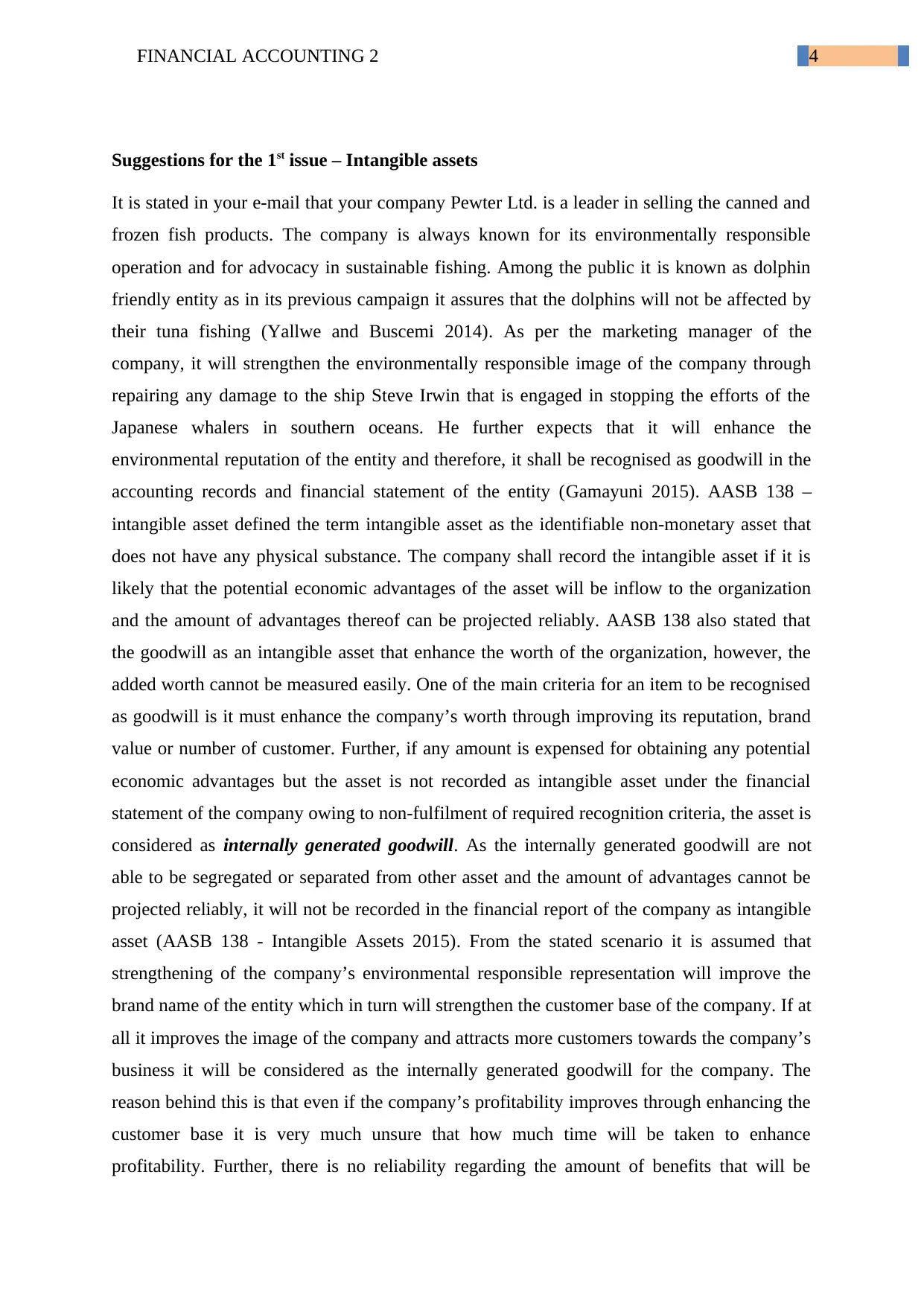
FINANCIAL ACCOUNTING 2 4
Suggestions for the 1st issue – Intangible assets
It is stated in your e-mail that your company Pewter Ltd. is a leader in selling the canned and
frozen fish products. The company is always known for its environmentally responsible
operation and for advocacy in sustainable fishing. Among the public it is known as dolphin
friendly entity as in its previous campaign it assures that the dolphins will not be affected by
their tuna fishing (Yallwe and Buscemi 2014). As per the marketing manager of the
company, it will strengthen the environmentally responsible image of the company through
repairing any damage to the ship Steve Irwin that is engaged in stopping the efforts of the
Japanese whalers in southern oceans. He further expects that it will enhance the
environmental reputation of the entity and therefore, it shall be recognised as goodwill in the
accounting records and financial statement of the entity (Gamayuni 2015). AASB 138 –
intangible asset defined the term intangible asset as the identifiable non-monetary asset that
does not have any physical substance. The company shall record the intangible asset if it is
likely that the potential economic advantages of the asset will be inflow to the organization
and the amount of advantages thereof can be projected reliably. AASB 138 also stated that
the goodwill as an intangible asset that enhance the worth of the organization, however, the
added worth cannot be measured easily. One of the main criteria for an item to be recognised
as goodwill is it must enhance the company’s worth through improving its reputation, brand
value or number of customer. Further, if any amount is expensed for obtaining any potential
economic advantages but the asset is not recorded as intangible asset under the financial
statement of the company owing to non-fulfilment of required recognition criteria, the asset is
considered as internally generated goodwill. As the internally generated goodwill are not
able to be segregated or separated from other asset and the amount of advantages cannot be
projected reliably, it will not be recorded in the financial report of the company as intangible
asset (AASB 138 - Intangible Assets 2015). From the stated scenario it is assumed that
strengthening of the company’s environmental responsible representation will improve the
brand name of the entity which in turn will strengthen the customer base of the company. If at
all it improves the image of the company and attracts more customers towards the company’s
business it will be considered as the internally generated goodwill for the company. The
reason behind this is that even if the company’s profitability improves through enhancing the
customer base it is very much unsure that how much time will be taken to enhance
profitability. Further, there is no reliability regarding the amount of benefits that will be
Suggestions for the 1st issue – Intangible assets
It is stated in your e-mail that your company Pewter Ltd. is a leader in selling the canned and
frozen fish products. The company is always known for its environmentally responsible
operation and for advocacy in sustainable fishing. Among the public it is known as dolphin
friendly entity as in its previous campaign it assures that the dolphins will not be affected by
their tuna fishing (Yallwe and Buscemi 2014). As per the marketing manager of the
company, it will strengthen the environmentally responsible image of the company through
repairing any damage to the ship Steve Irwin that is engaged in stopping the efforts of the
Japanese whalers in southern oceans. He further expects that it will enhance the
environmental reputation of the entity and therefore, it shall be recognised as goodwill in the
accounting records and financial statement of the entity (Gamayuni 2015). AASB 138 –
intangible asset defined the term intangible asset as the identifiable non-monetary asset that
does not have any physical substance. The company shall record the intangible asset if it is
likely that the potential economic advantages of the asset will be inflow to the organization
and the amount of advantages thereof can be projected reliably. AASB 138 also stated that
the goodwill as an intangible asset that enhance the worth of the organization, however, the
added worth cannot be measured easily. One of the main criteria for an item to be recognised
as goodwill is it must enhance the company’s worth through improving its reputation, brand
value or number of customer. Further, if any amount is expensed for obtaining any potential
economic advantages but the asset is not recorded as intangible asset under the financial
statement of the company owing to non-fulfilment of required recognition criteria, the asset is
considered as internally generated goodwill. As the internally generated goodwill are not
able to be segregated or separated from other asset and the amount of advantages cannot be
projected reliably, it will not be recorded in the financial report of the company as intangible
asset (AASB 138 - Intangible Assets 2015). From the stated scenario it is assumed that
strengthening of the company’s environmental responsible representation will improve the
brand name of the entity which in turn will strengthen the customer base of the company. If at
all it improves the image of the company and attracts more customers towards the company’s
business it will be considered as the internally generated goodwill for the company. The
reason behind this is that even if the company’s profitability improves through enhancing the
customer base it is very much unsure that how much time will be taken to enhance
profitability. Further, there is no reliability regarding the amount of benefits that will be
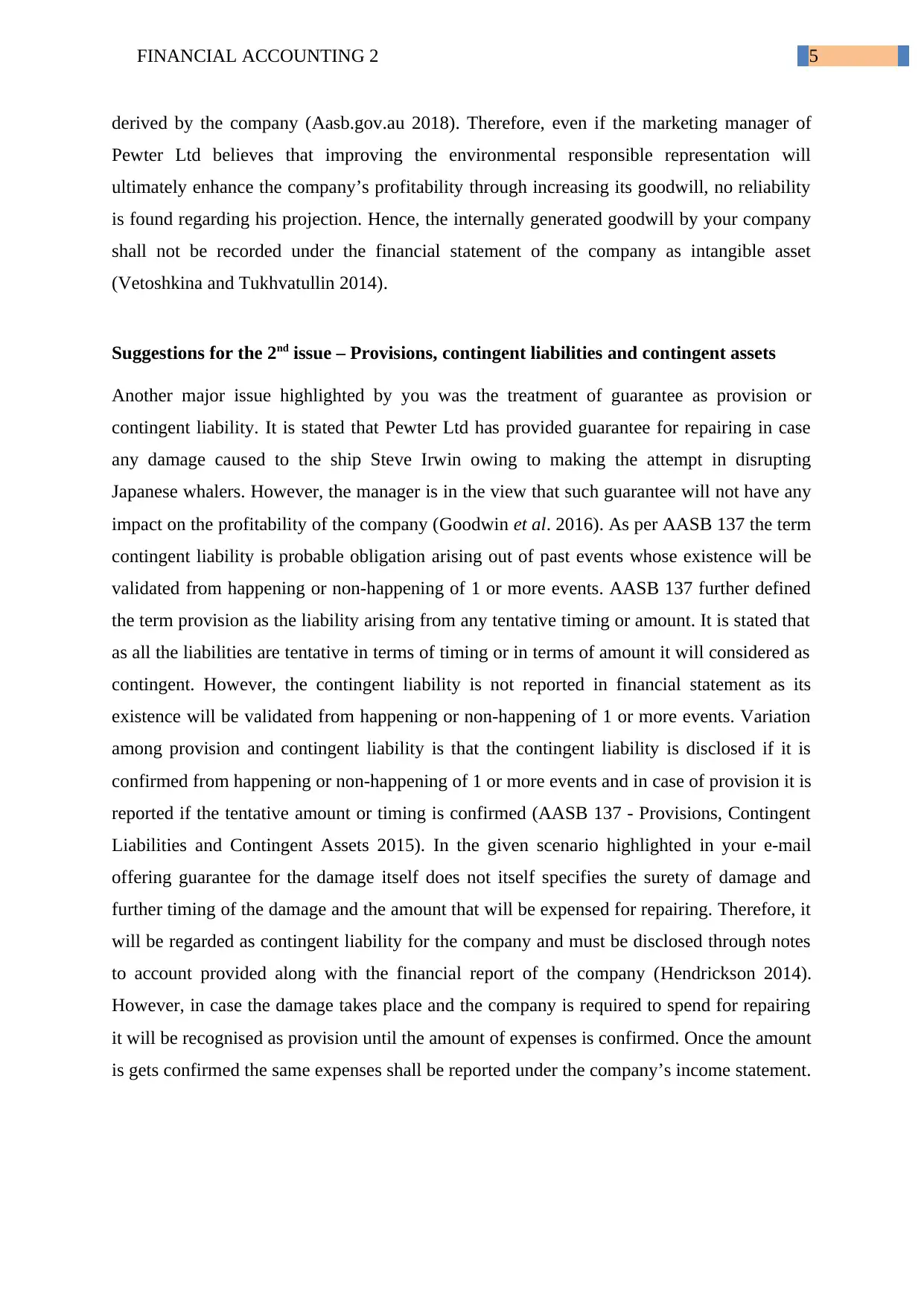
FINANCIAL ACCOUNTING 2 5
derived by the company (Aasb.gov.au 2018). Therefore, even if the marketing manager of
Pewter Ltd believes that improving the environmental responsible representation will
ultimately enhance the company’s profitability through increasing its goodwill, no reliability
is found regarding his projection. Hence, the internally generated goodwill by your company
shall not be recorded under the financial statement of the company as intangible asset
(Vetoshkina and Tukhvatullin 2014).
Suggestions for the 2nd issue – Provisions, contingent liabilities and contingent assets
Another major issue highlighted by you was the treatment of guarantee as provision or
contingent liability. It is stated that Pewter Ltd has provided guarantee for repairing in case
any damage caused to the ship Steve Irwin owing to making the attempt in disrupting
Japanese whalers. However, the manager is in the view that such guarantee will not have any
impact on the profitability of the company (Goodwin et al. 2016). As per AASB 137 the term
contingent liability is probable obligation arising out of past events whose existence will be
validated from happening or non-happening of 1 or more events. AASB 137 further defined
the term provision as the liability arising from any tentative timing or amount. It is stated that
as all the liabilities are tentative in terms of timing or in terms of amount it will considered as
contingent. However, the contingent liability is not reported in financial statement as its
existence will be validated from happening or non-happening of 1 or more events. Variation
among provision and contingent liability is that the contingent liability is disclosed if it is
confirmed from happening or non-happening of 1 or more events and in case of provision it is
reported if the tentative amount or timing is confirmed (AASB 137 - Provisions, Contingent
Liabilities and Contingent Assets 2015). In the given scenario highlighted in your e-mail
offering guarantee for the damage itself does not itself specifies the surety of damage and
further timing of the damage and the amount that will be expensed for repairing. Therefore, it
will be regarded as contingent liability for the company and must be disclosed through notes
to account provided along with the financial report of the company (Hendrickson 2014).
However, in case the damage takes place and the company is required to spend for repairing
it will be recognised as provision until the amount of expenses is confirmed. Once the amount
is gets confirmed the same expenses shall be reported under the company’s income statement.
derived by the company (Aasb.gov.au 2018). Therefore, even if the marketing manager of
Pewter Ltd believes that improving the environmental responsible representation will
ultimately enhance the company’s profitability through increasing its goodwill, no reliability
is found regarding his projection. Hence, the internally generated goodwill by your company
shall not be recorded under the financial statement of the company as intangible asset
(Vetoshkina and Tukhvatullin 2014).
Suggestions for the 2nd issue – Provisions, contingent liabilities and contingent assets
Another major issue highlighted by you was the treatment of guarantee as provision or
contingent liability. It is stated that Pewter Ltd has provided guarantee for repairing in case
any damage caused to the ship Steve Irwin owing to making the attempt in disrupting
Japanese whalers. However, the manager is in the view that such guarantee will not have any
impact on the profitability of the company (Goodwin et al. 2016). As per AASB 137 the term
contingent liability is probable obligation arising out of past events whose existence will be
validated from happening or non-happening of 1 or more events. AASB 137 further defined
the term provision as the liability arising from any tentative timing or amount. It is stated that
as all the liabilities are tentative in terms of timing or in terms of amount it will considered as
contingent. However, the contingent liability is not reported in financial statement as its
existence will be validated from happening or non-happening of 1 or more events. Variation
among provision and contingent liability is that the contingent liability is disclosed if it is
confirmed from happening or non-happening of 1 or more events and in case of provision it is
reported if the tentative amount or timing is confirmed (AASB 137 - Provisions, Contingent
Liabilities and Contingent Assets 2015). In the given scenario highlighted in your e-mail
offering guarantee for the damage itself does not itself specifies the surety of damage and
further timing of the damage and the amount that will be expensed for repairing. Therefore, it
will be regarded as contingent liability for the company and must be disclosed through notes
to account provided along with the financial report of the company (Hendrickson 2014).
However, in case the damage takes place and the company is required to spend for repairing
it will be recognised as provision until the amount of expenses is confirmed. Once the amount
is gets confirmed the same expenses shall be reported under the company’s income statement.
⊘ This is a preview!⊘
Do you want full access?
Subscribe today to unlock all pages.

Trusted by 1+ million students worldwide
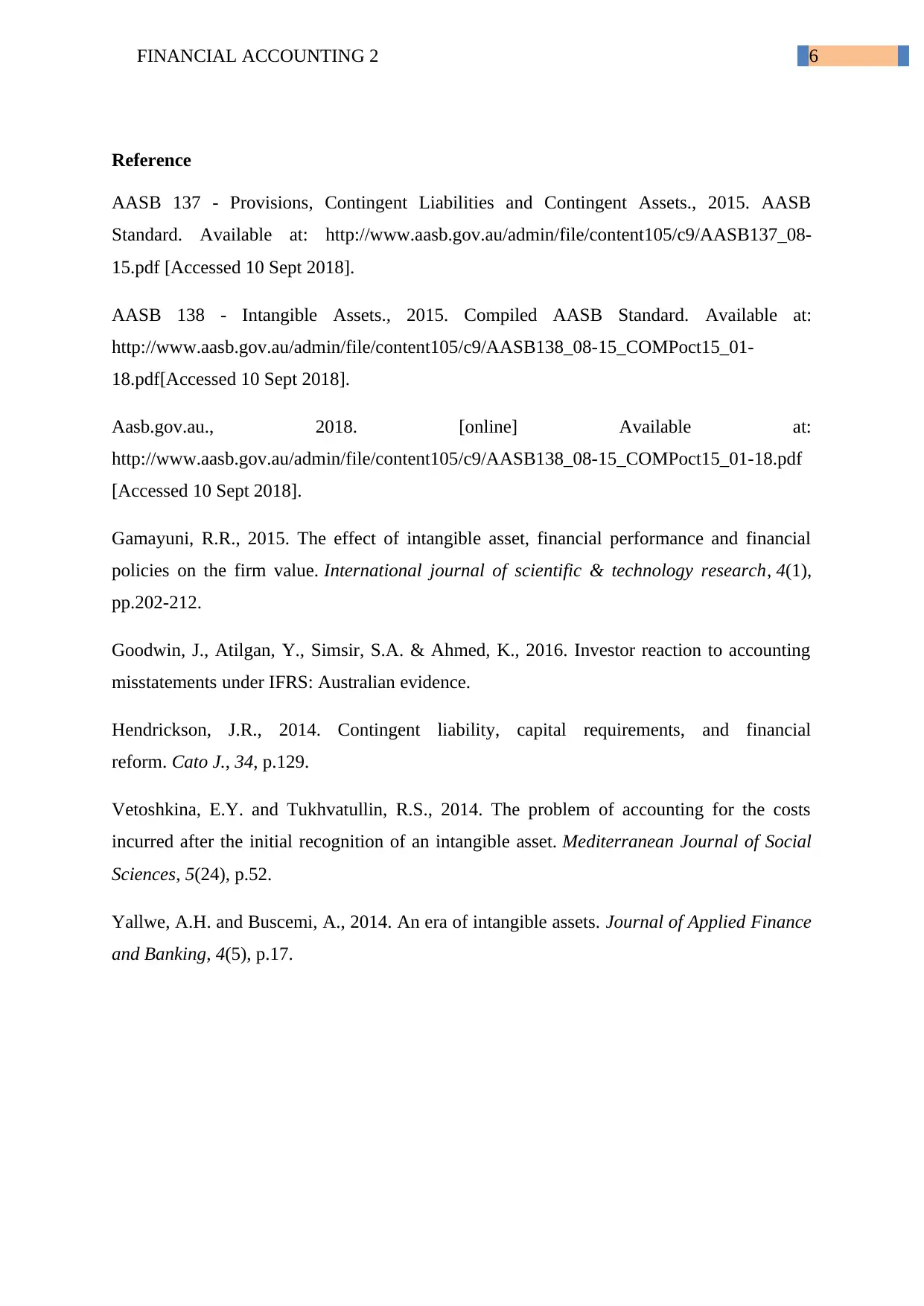
FINANCIAL ACCOUNTING 2 6
Reference
AASB 137 - Provisions, Contingent Liabilities and Contingent Assets., 2015. AASB
Standard. Available at: http://www.aasb.gov.au/admin/file/content105/c9/AASB137_08-
15.pdf [Accessed 10 Sept 2018].
AASB 138 - Intangible Assets., 2015. Compiled AASB Standard. Available at:
http://www.aasb.gov.au/admin/file/content105/c9/AASB138_08-15_COMPoct15_01-
18.pdf[Accessed 10 Sept 2018].
Aasb.gov.au., 2018. [online] Available at:
http://www.aasb.gov.au/admin/file/content105/c9/AASB138_08-15_COMPoct15_01-18.pdf
[Accessed 10 Sept 2018].
Gamayuni, R.R., 2015. The effect of intangible asset, financial performance and financial
policies on the firm value. International journal of scientific & technology research, 4(1),
pp.202-212.
Goodwin, J., Atilgan, Y., Simsir, S.A. & Ahmed, K., 2016. Investor reaction to accounting
misstatements under IFRS: Australian evidence.
Hendrickson, J.R., 2014. Contingent liability, capital requirements, and financial
reform. Cato J., 34, p.129.
Vetoshkina, E.Y. and Tukhvatullin, R.S., 2014. The problem of accounting for the costs
incurred after the initial recognition of an intangible asset. Mediterranean Journal of Social
Sciences, 5(24), p.52.
Yallwe, A.H. and Buscemi, A., 2014. An era of intangible assets. Journal of Applied Finance
and Banking, 4(5), p.17.
Reference
AASB 137 - Provisions, Contingent Liabilities and Contingent Assets., 2015. AASB
Standard. Available at: http://www.aasb.gov.au/admin/file/content105/c9/AASB137_08-
15.pdf [Accessed 10 Sept 2018].
AASB 138 - Intangible Assets., 2015. Compiled AASB Standard. Available at:
http://www.aasb.gov.au/admin/file/content105/c9/AASB138_08-15_COMPoct15_01-
18.pdf[Accessed 10 Sept 2018].
Aasb.gov.au., 2018. [online] Available at:
http://www.aasb.gov.au/admin/file/content105/c9/AASB138_08-15_COMPoct15_01-18.pdf
[Accessed 10 Sept 2018].
Gamayuni, R.R., 2015. The effect of intangible asset, financial performance and financial
policies on the firm value. International journal of scientific & technology research, 4(1),
pp.202-212.
Goodwin, J., Atilgan, Y., Simsir, S.A. & Ahmed, K., 2016. Investor reaction to accounting
misstatements under IFRS: Australian evidence.
Hendrickson, J.R., 2014. Contingent liability, capital requirements, and financial
reform. Cato J., 34, p.129.
Vetoshkina, E.Y. and Tukhvatullin, R.S., 2014. The problem of accounting for the costs
incurred after the initial recognition of an intangible asset. Mediterranean Journal of Social
Sciences, 5(24), p.52.
Yallwe, A.H. and Buscemi, A., 2014. An era of intangible assets. Journal of Applied Finance
and Banking, 4(5), p.17.
1 out of 7
Related Documents
Your All-in-One AI-Powered Toolkit for Academic Success.
+13062052269
info@desklib.com
Available 24*7 on WhatsApp / Email
![[object Object]](/_next/static/media/star-bottom.7253800d.svg)
Unlock your academic potential
Copyright © 2020–2025 A2Z Services. All Rights Reserved. Developed and managed by ZUCOL.





